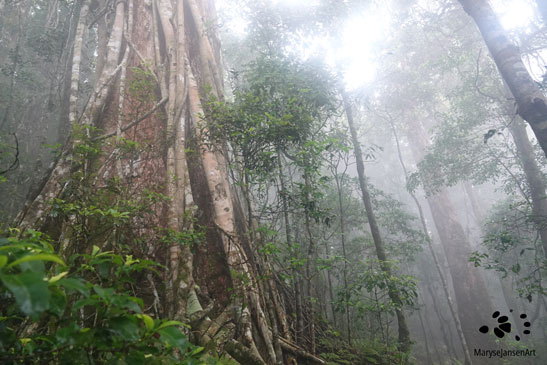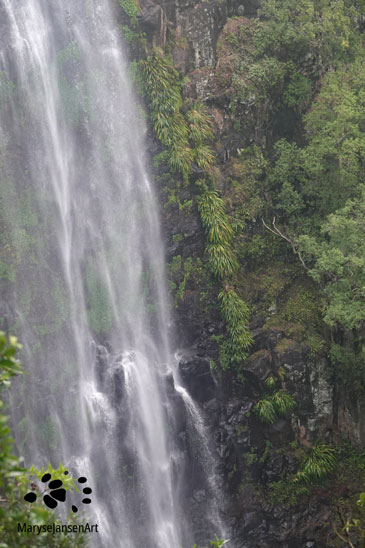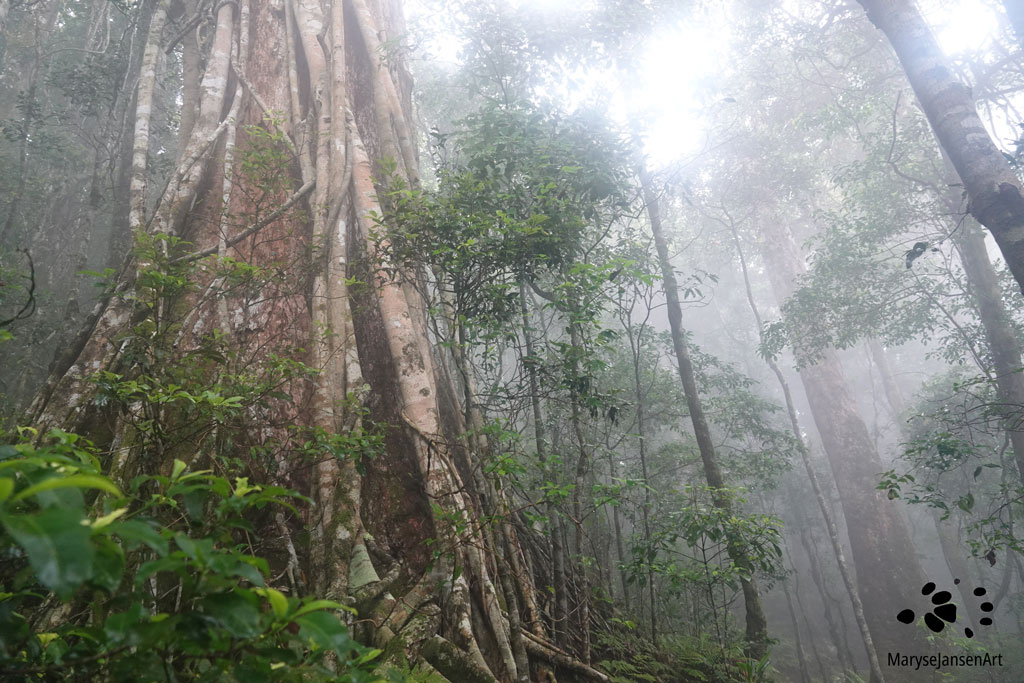Nature Photography with marysejansenart
This is a rainforest, it’s supposed to rain!

Flashes of intense bright light and an immense racket keep waking me up during the night in the Lamington Rainforest. We are being hit by massive thunderstorms and it’s hard to find words to describe the amount of water that is pouring down from the sky! The noise on the roof of the tent is deafening! I am so grateful to be ‘glamping’, even though this is not normally my style! I feel for the more primitive campers who literally must be floating on their airbeds! Despite staying in a tent on poles, I still have to wade to the toilet building. I remind myself that I’m in a rainforest and therefore it’s supposed to rain!
Table of Contents
UNESCO Gondwana Rainforests World Heritage Area
Thankfully in the early morning the rain and thunder ease and I look forward to exploring the hiking trails of Lamington National Park.
Lamington National Park is part of the UNESCO Gondwana Rainforests of Australia World Heritage Area. This extensive title recognises the fact that this pocket of rainforest is similar to the rainforest that once covered the ancient super-continent Gondwana that existed 500-550 million years ago. Around 180 million years ago this continent started to break up and eventually separated into Africa, South America, Antarctica, India, the Arabian peninsula and Australia.
Gondwana rainforests are the pockets of rainforest that we inherited from the Gondwana continent that still remain in New South Wales and Queensland, They are biodiversity hot spots, where ancient species survive together with species that evolved in modern times. Pretty special!
Using the fog to my advantage
A thick fog suddenly changes the scene as I set off on my walk. The storms were so bad that a lot of the trails have been closed, due to flooding of the tracks and fallen trees in various places. The park rangers first need to establish that everything is safe before they will open up the tracks for hikers again. Luckily there are so many tracks in this area that there are still a couple of options for me to choose from!
I decide to go to Morans Falls. It’s a 4.4km walk which meanders through a stunning part of the forest.
The fog adds a spectacular beauty to the landscape which I use to my advantage in my photography. Rainforest photography is not the easiest as it’s usually quite dark but this fog ads a beautiful dimension, a bit of brightness and above all a mystical atmosphere!
Layers of the rainforest
There is an enormous variation in the vegetation. There are the big, tall trees aka ‘Rainforest Giants’, and numerous species of other trees big and small, covering all levels of height in the forest. Rainforests are tree-dominated communities with a closed canopy. That means only very small amounts of sunlight make it down to the forest floor. As a consequence not many types of ground cover can survive here. There are some shrubs, lots of ferns, mosses, there are fungi and lychen, creepers and climbers.
A rainforest can typically be divided in four layers. Each layer not only contains specific plants and trees but also houses the animals that thrive in that particular layer.
- The top layer of a rainforest is called the emergent layer. This is where the very tall trees emerge to reach for the sunlight. Large birds of prey, bats and butterflies can be seen here.
- Just below that is the canopy, which is a thick, dense layer of branches and leaves that literally creates a roof for the layers below and protects them from the elements. This layer has the biggest diversity of species, including possums, gliders, pythons and pigeons.
- Below the canopy exists a dark, damp environment. Certain trees and plants such as ferns and palms thrive in this third layer, called the understorey. This is a perfect layer for birds such as fantails, whistlers and parrots.
- And finally, ground level, is called the forest floor. It’s always dark and that combined with the humidity makes it a perfect place for decay and composting of plant and animal matter. This is where fungi and mosses thrive. You may see skinks, lizards and pademelons here, as well as logrunners, brush turkeys and bowerbirds.
Strangler Fig Tree
Have a look at the Giant Strangler Fig Tree that’s developing in the foreground of the featured photo. Strangler Figs are impressive trees and they have an interesting story.
They begin to grow as a seed gets dropped by a bird on another tree. The seed germinates and begins its life as an epiphyte. It grows as a vine and begins to form roots that start to strangle the host tree on their way to the soil. More and more roots are formed and eventually the host tree gets killed, leaving the Fig Tree to stand on its own! The myriad of roots creates interesting shapes and turn the trees into special features of the landscape. The fruit is well loved by many birds.
Morans Falls
As I keep wandering I hear a thunderous noise, but this time it’s not a thunderstorm. Phew! Rather, it is the consequence of last night’s weather. It is the waterfall which, as it has received a lot of water overnight, comes crashing down at full force! The 80 metre drop makes a massive thundering noise as this plunge waterfall finds its way down into Morans Creek Gorge. It’s a spectacular sight!

If you are interested in purchasing ‘Lamington Rainforest’ or would like to see what it looks like on the various products, please head to my shop.
If you are interested in ‘Falls in the Rainforest’, click shop here.


